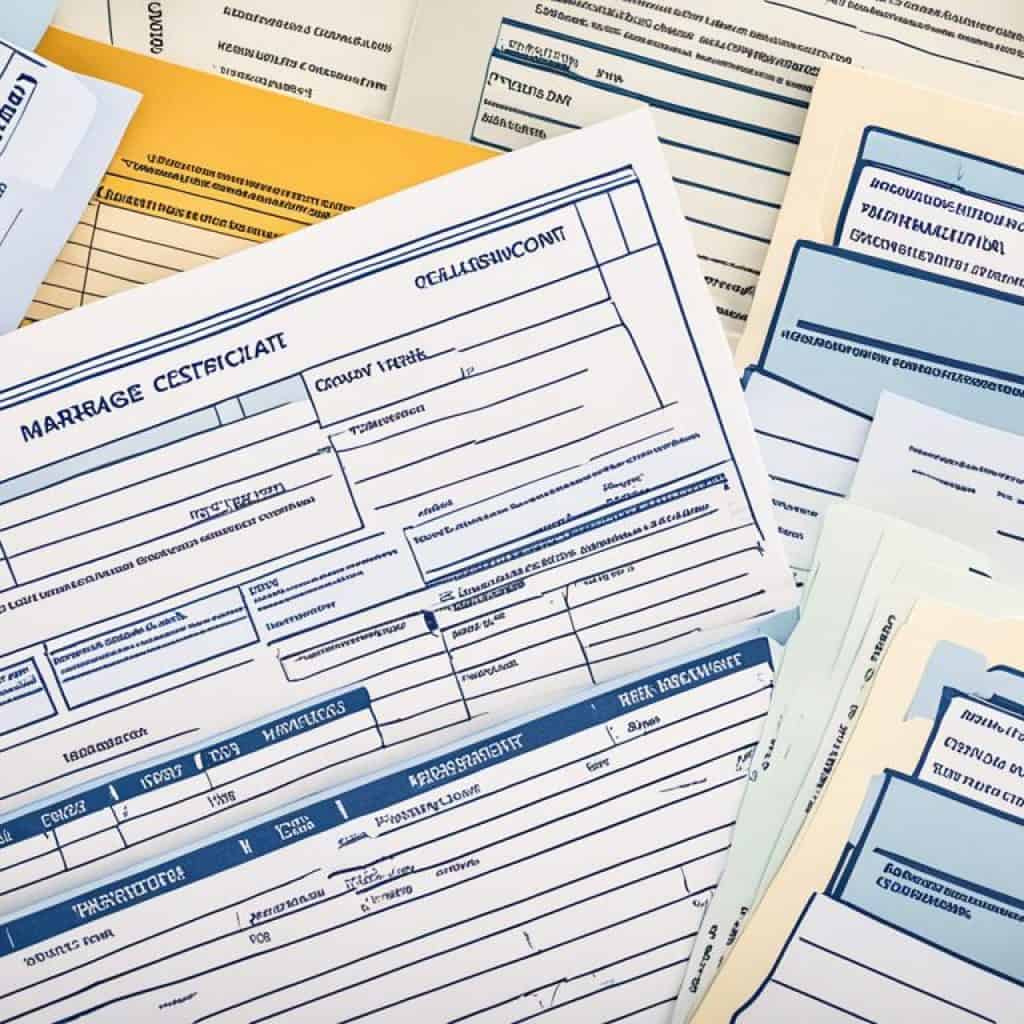Have you ever wondered how to bring your wife to the USA from the Philippines? It can be a complex process that involves navigating the K1 visa process, meeting US immigration requirements, and understanding the necessary steps to obtain a Filipino spouse visa or a marriage-based visa for the USA. But fear not, as this guide will provide you with all the necessary information and steps to make the process smooth and easy.
So, are you ready to embark on this journey and bring your wife to the USA? Let’s dive into the details and uncover how you can navigate the process successfully.
Key Takeaways:
- Understand the K1 visa process and its importance in bringing your wife to the USA.
- Familiarize yourself with the US immigration requirements for a Filipino spouse visa or a marriage-based visa.
- Learn how to apply for the spouse visa and prepare for the visa interview.
- Discover the process of obtaining a Green Card for your spouse and maintaining permanent residency.
- Get valuable tips for a successful visa interview and the required supporting documents.
Understanding the K1 Visa Process
The K1 visa process is an essential process to bring your wife to the USA from the Philippines. This nonimmigrant visa allows your spouse to join you in the US while you both prepare for marriage. To initiate the process, you must file a Form I-129F, Petition for Alien Fiancé(e), with the US Citizenship and Immigration Services (USCIS). Once the petition is approved, your spouse can proceed with applying for the K1 visa and attend a visa interview at the US embassy in Manila. Effective preparation for the visa interview requires gathering all the necessary documents and practicing interview questions. It is vital to be well-prepared to increase your chances of a successful and smooth visa interview process.
K1 Visa Process Overview
| Step | Description |
|---|---|
| 1 | File a Form I-129F, Petition for Alien Fiancé(e), with USCIS. |
| 2 | Wait for USCIS approval of the petition. |
| 3 | Proceed with the K1 visa application at the US embassy in Manila. |
| 4 | Gather all necessary documents for the visa interview. |
| 5 | Attend the visa interview at the US embassy. |
| 6 | Upon approval, your spouse receives the K1 visa. |
By following these steps and providing thorough documentation, you can navigate the K1 visa process smoothly and successfully bring your wife to the USA.
Meeting the US Immigration Requirements
To bring your wife to the USA, you must meet certain US immigration requirements. These requirements are in place to ensure that the marriage is genuine and that the sponsoring spouse has the financial means to support their partner.
US Citizenship or Lawful Permanent Residency
The first requirement is that you must be a US citizen or a lawful permanent resident (Green Card holder). This is necessary to sponsor your spouse for a visa or a green card.
Valid and Bona Fide Marriage
You and your spouse must have a valid and bona fide marriage, meaning that it is legally recognized and based on a genuine relationship. This requirement prevents fraudulent marriages for the purpose of immigration benefits.
Financial Support
You must also demonstrate that you have the financial means to support your spouse and prevent them from becoming a public charge. This requirement can be fulfilled by submitting the Form I-864, Affidavit of Support, which shows your income, assets, and ability to financially support your spouse.
Filing the Appropriate Forms
Depending on your particular situation, you will need to file the appropriate forms, such as the Form I-130, Petition for Alien Relative, or the Form I-129F, Petition for Alien Fiancé(e). These forms initiate the process of sponsoring your spouse for a visa or a green card.
To ensure a smooth visa process and avoid any delays or complications, it is crucial to carefully follow the US immigration requirements. By meeting these requirements, you can bring your Filipino spouse to the USA and start your life together.
Applying for the Filipino Spouse Visa
Once you have met the US immigration requirements, you can apply for the Filipino spouse visa. This involves submitting the necessary forms to the USCIS, such as the Form I-130 or the Form I-129F, depending on your specific situation. These forms serve as petitions to establish the relationship between you and your spouse and initiate the visa application process.
After your petition is approved by the USCIS, it will be forwarded to the US embassy in Manila for further processing. The embassy will schedule a visa interview for your spouse, during which they will need to provide supporting documents and demonstrate their eligibility for the Filipino spouse visa. It is important to carefully review the required documents and ensure they are complete and well-organized.
Preparing for the visa interview is crucial to increase the chances of a successful outcome. Your spouse should anticipate questions related to your relationship, personal history, and intentions in the US. It is advisable to practice answering common interview questions and gather any additional evidence that may strengthen your case.

Key Tips for a Successful Visa Interview:
- Arrive early to the interview and dress professionally to make a good impression.
- Bring all the required documents and make sure they are well-organized and easy to access.
- Be honest and concise when answering the interviewer’s questions.
- Demonstrate the genuineness of your relationship through photos, correspondence, and other supporting evidence.
- Stay calm and composed throughout the interview, as nervousness can sometimes give a wrong impression.
Remember, the visa interview is an opportunity to demonstrate your eligibility and strengthen your case. By being well-prepared, organized, and confident, you can navigate the process smoothly and increase the likelihood of a successful visa application for your spouse.
Understanding the Green Card Process
Once your spouse has entered the US on a K1 visa or obtained a Filipino spouse visa, the next step is to obtain a Green Card, which grants permanent residency. This can be done through the CR1 visa process. The CR1 visa is an immigrant visa for spouses of US citizens. To apply for the Green Card, you will need to file the Form I-485, Application to Register Permanent Residence or Adjust Status. It is important to gather all the necessary supporting documents and follow the instructions provided by the USCIS to ensure a smooth Green Card application process.
CR1 Visa Overview
The CR1 visa, also known as the Conditional Resident visa, is specifically designed for spouses of US citizens. It allows the foreign spouse to enter the US with permanent residency status. The CR1 visa is obtained after the USCIS approves the immigrant petition filed by the US citizen spouse, and the process involves completing the Form I-130, Petition for Alien Relative. It is important to note that the CR1 visa is conditional if the marriage is less than 2 years old, requiring the couple to jointly apply to remove these conditions after 2 years of marriage.
Form I-485: Application to Register Permanent Residence or Adjust Status
The Form I-485 is the application used to apply for a Green Card. It is necessary for your spouse to file this form to adjust their status and obtain permanent residency in the US. The form requires detailed information about your spouse’s personal background, immigration history, employment history, and criminal record. It is crucial to complete the form accurately and include all required supporting documents to avoid delays or possible denials in the application process.
Required Supporting Documents
When applying for a Green Card through the CR1 visa process, it is essential to provide the necessary supporting documents to demonstrate your eligibility. These documents may include:
- Marriage certificate
- Valid passports for both spouses
- Birth certificates
- Proof of bona fide marriage
- Financial support documents
- Police certificates
The exact documents required may vary depending on individual circumstances, so it is important to carefully review the USCIS guidelines and instructions for the Form I-485 to ensure you include all the necessary documentation.
Interview Process
After filing the Form I-485 and submitting the required supporting documents, your spouse will be scheduled for an interview with a USCIS officer. During the interview, the officer will review the application and documents, ask questions about the marriage and relationship, and assess the eligibility for permanent residency. It is crucial for both you and your spouse to be well-prepared for this interview by practicing potential interview questions, reviewing your application, and bringing any additional documentation that may strengthen your case.
Important note: Due to the COVID-19 pandemic, interview processes may have changed. It is essential to check the USCIS website for the most up-to-date information regarding interview procedures and requirements.
Appeals and Denials
In the event of a Green Card application denial, you have the right to appeal the decision. The denial notice will include instructions on how to file an appeal and the timeframe for doing so. It is crucial to consult an experienced immigration attorney if you encounter a denial to guide you through the appeals process and increase your chances of success.
Tips for a Successful Visa Interview
The visa interview is a crucial step in the process of bringing your wife to the USA. To ensure a successful interview, it is important to come prepared. Here are some tips to help you navigate the visa interview with confidence:
- Dress professionally: Your appearance plays a significant role in making a positive impression. Dress smartly and professionally to convey seriousness and respect for the process.
- Be honest and confident: Answer all interview questions truthfully and confidently. Avoid providing misleading or inconsistent information. Honesty is key.
- Provide all necessary documents: Bring all required supporting documents to the interview, including passports, forms, marriage certificates, financial documents, and any other requested paperwork. Be organized and ready to present them if requested.
- Demonstrate your genuine relationship: Be prepared to answer questions about your relationship with your spouse. Provide evidence, such as photographs, joint bank statements, correspondence, or any other documentation that proves the authenticity of your marriage.
- Be aware of potential red flags: Understand common red flags that immigration officers may look for during the interview, such as inconsistencies in answers or suspicious documents. Address any concerns proactively and provide additional evidence, if necessary.
By following these tips and being well-prepared, you can increase your chances of a successful visa interview at the US embassy in Manila. Remember to stay calm, composed, and respectful during the interview process.
Understanding the Required Documents
When applying for a spouse visa to the United States, it is crucial to gather and provide the necessary documents to demonstrate your eligibility. These documents play a vital role in the visa application process and help prove the authenticity of your relationship.
Here are the required documents you will need to prepare:
- A valid passport: Ensure that both you and your spouse have valid passports.
- DS-230 forms: Fill out and submit the DS-230 forms accurately and completely.
- Birth certificates: Provide official birth certificates for both you and your spouse.
- NBI clearance: Obtain National Bureau of Investigation (NBI) clearances for both you and your spouse from the Philippines.
- Police certificates: Obtain police certificates from all countries where you and your spouse have lived for more than six months.
- Marriage records: Gather official marriage records or certificates to prove your legal union.
- Military records (if applicable): If either you or your spouse have served in the military, provide military records.
- Supporting evidence of identity and relationship: Gather any additional documents that help establish your identity and demonstrate the authenticity of your relationship, such as photographs together, joint bank account statements, and correspondence.
It is crucial to ensure that all your documents are in order before attending the visa interview. Organize them neatly and logically, making them easily accessible during the application process. This preparation will help prevent any delays or rejections and improve the chances of a successful visa application.
Sample Supporting Documents:
| Document Type | Description |
|---|---|
| Passport | A valid passport for both the petitioner and the beneficiary. |
| DS-230 Forms | Accurately completed DS-230 forms for both the petitioner and the beneficiary. |
| Birth Certificates | Official birth certificates for the petitioner and the beneficiary. |
| NBI Clearance | National Bureau of Investigation (NBI) clearances for both the petitioner and the beneficiary. |
| Police Certificates | Police certificates from countries where the petitioner and the beneficiary have resided for more than six months. |
| Marriage Records | Official marriage records or certificates to prove the legal union between the petitioner and the beneficiary. |
| Military Records | Military records (if applicable) for either the petitioner or the beneficiary who have served in the military. |
| Supporting Evidence | Additional documents showcasing the authenticity of the relationship, such as photographs, joint bank account statements, and correspondence. |
Preparation and organization are key when it comes to gathering the required documents for your spouse visa application. By providing thorough and accurate documentation, you increase your chances of a smooth and successful visa process.

Meeting Financial Support Requirements
As the petitioner, it is essential to meet the financial support requirements to ensure a smooth immigration process for your spouse. One of the key documents you will need to submit is the Form I-864, Affidavit of Support. This form demonstrates your ability to financially support your spouse and prevents them from becoming a public charge in the United States.
The Form I-864 requires you to provide evidence of your income and assets, emphasizing your financial stability. By carefully filling out the form and gathering all the necessary supporting documents, you can meet the financial support requirements and strengthen your spouse’s visa application.
The Affidavit of Support serves as a legal contract between you and the US government, ensuring that you take responsibility for supporting your spouse financially. It is an essential part of the immigration process, demonstrating your commitment and ability to provide for your spouse’s needs in the United States.
To successfully complete the Form I-864, gather the following supporting documents:
- Recent tax returns: Provide copies of your most recent federal tax returns, including the W-2 forms or 1099 statements.
- Employment verification: Include a letter from your employer, stating your current position, salary, and duration of employment.
- Pay stubs: Submit recent pay stubs that show your earnings and deductions.
- Bank statements: Include statements from your bank accounts, demonstrating your financial stability and ability to support your spouse.
- Asset documentation: If you have significant assets, such as properties or investments, provide documents that verify their value.
By providing comprehensive and accurate documentation, you can strengthen your case and satisfy the US immigration requirements related to financial support.
Sample Table: Financial Support Documents
| Document | Description |
|---|---|
| Recent Tax Returns | Copies of your most recent federal tax returns, including W-2 forms or 1099 statements. |
| Employment Verification | A letter from your employer, stating your current position, salary, and duration of employment. |
| Pay Stubs | Recent pay stubs that show your earnings and deductions. |
| Bank Statements | Statements from your bank accounts, demonstrating your financial stability and ability to support your spouse. |
| Asset Documentation | Documents that verify the value of any significant assets you possess, such as properties or investments. |
By diligently completing the Form I-864 and providing the required supporting documents, you showcase your financial capacity to support your spouse during their journey to the United States.
Understanding Conditional Residence and Removing Conditions
When your spouse is granted permanent residency, it may be on a conditional basis if your marriage is less than 2 years old. To remove the conditions on residence, you and your spouse must file the Form I-751, Petition to Remove Conditions of Residence, within the 90-day period before the expiration date on the conditional resident card. Failure to file during this time can result in the termination of your spouse’s resident status. It is important to understand the process and timeline for removing the conditions on residence to maintain your spouse’s permanent residency.
Removing the conditions on residence is a crucial step in securing a permanent green card for your spouse. It signifies the transition from temporary conditional residency to full permanent residency.
Why Conditional Residence?
The purpose of temporary conditional residency is to verify the authenticity of your marriage and ensure that it is not a fraudulent attempt to obtain a green card. The United States Citizenship and Immigration Services (USCIS) wants to ensure that the marriage is genuine and not solely for immigration purposes.
Filing Form I-751
To remove the conditions on residence, you and your spouse must file the Form I-751. This form serves as a petition to the USCIS to remove the conditions and grant your spouse permanent residency.
| Key Details | Form I-751 |
|---|---|
| Type of Form | Petition to Remove Conditions of Residence |
| Filing Window | Within the 90-day period before the expiration date on the conditional resident card |
| Required Documents | Evidence of a bona fide marriage, joint financial liabilities, cohabitation, and more (as specified by USCIS) |
| Filing Fee | As per current USCIS fee schedule (subject to change) |
| Form Submission | By mail to the USCIS lockbox or electronically, if eligible |
| Processing Time | Varies, typically several months |
Ensure that you submit the Form I-751 and all required documents within the specified filing window. Failure to meet this deadline may result in the termination of your spouse’s resident status. It is recommended to submit the petition as early as possible to avoid any processing delays.
Supporting Documents
When filing the Form I-751, you will need to submit supporting documents to demonstrate the genuineness of your marriage. These documents can include:
Gathering comprehensive and convincing evidence of your bona fide marriage is crucial to ensure a successful outcome.
Approval and Next Steps
Once the USCIS receives your petition, they will review your case and may schedule an interview to further assess the validity of your marriage. If everything goes well, your spouse will receive their permanent green card, removing the conditions on their residence.
“Removing the conditions on residence is a significant milestone in the immigration journey of a married couple. It solidifies their status as permanent residents of the United States and paves the way for future opportunities and stability.”
It is important to seek legal advice or consult with an immigration attorney to ensure that you meet all the necessary requirements and submit a robust petition. Their expertise can help you navigate the process and increase your chances of a successful outcome.
Exploring Special Cases and Exceptions
In some cases, there may be special circumstances or exceptions that apply to your situation when it comes to visa applications and US immigration requirements. It is important to be aware of these special cases as they may provide you with additional benefits or provisions.
If you or your spouse is in the US military, for example, there may be specific benefits available to you. These benefits could include expedited processing, waiver of certain requirements, or access to special programs designed for military personnel and their families.
Researching and understanding these special cases can help you take full advantage of any available options and simplify the immigration process. Consulting an immigration attorney or reaching out to the US Citizenship and Immigration Services (USCIS) can provide you with further guidance and clarification specific to your situation.
By exploring special cases and exceptions, you can ensure that you are making informed decisions and maximizing your chances of a successful visa application and immigration journey.

Options for Fiancé(e) Visas
If you are engaged and not yet married, you may consider applying for a fiancé(e) visa instead of a spouse visa. The K1 visa is a nonimmigrant visa that allows your fiancé(e) to enter the US and marry you within 90 days. To apply for the K1 visa, you will need to file the Form I-129F, Petition for Alien Fiancé(e), with the US Citizenship and Immigration Services (USCIS). Once approved, your fiancé(e) can attend a visa interview at the US embassy in Manila and enter the US on a K1 visa. It is important to understand the process and requirements for the K1 visa to ensure a successful application.
Appeals and Denials
In some cases, visa petition denials can occur in the immigration process. If this happens to you, it is important to know that you have the option to appeal the decision. The appeals process provides an opportunity for the denial to be reviewed and potentially overturned. To initiate the appeal, you will need to follow the instructions provided in the denial letter and adhere to the specified timeframe for filing the appeal.
The appeal will be referred to the Board of Immigration Appeals (BIA) for further review. The BIA is an appellate body within the Department of Justice that evaluates immigration matters and makes independent decisions. They will carefully review the facts and circumstances related to your case and determine whether the original decision should be upheld or reversed.
When filing an appeal, it is crucial to pay attention to detail and provide compelling arguments supported by relevant evidence. Consulting with an immigration attorney who specializes in appeals can greatly increase your chances of success. They can guide you through the process, help you gather the necessary documentation, and present a strong case on your behalf.
Remember, the appeals process can be complex and time-consuming, but it offers a second chance to present your case and overcome a visa denial. Don’t hesitate to seek professional advice and assistance to navigate this challenging process.
| Appeals and Denials | Key Points |
|---|---|
| Visa Petition Denials | – Denial letter provides instructions for appeal – Appeals must be filed within a specified timeframe |
| Appeals Process | – Appeals referred to the Board of Immigration Appeals (BIA) – BIA independently reviews and makes decisions |
| Board of Immigration Appeals | – BIA reviews facts, circumstances, and arguments – Determines whether to uphold or reverse the original decision |
| Consulting an Immigration Attorney | – Immigration attorney specializing in appeals can provide guidance and support – Helps gather documentation and present a strong case |
Following-to-Join Benefits
If you became a permanent resident through a preference classification and have family members who did not obtain permanent residence at the same time, they may be eligible for following-to-join benefits. This means that you do not have to submit a separate petition for your spouse and/or children, and they do not have to wait for a visa number to become available. Instead, they can apply for an immigrant visa by notifying a US consulate or embassy of your permanent residency. The specific requirements and process for following-to-join benefits may vary, so it is important to seek guidance from the National Visa Center or an immigration attorney.
Conclusion
Bringing your wife to the USA from the Philippines can be a complex process, but with the right information and preparation, you can navigate the immigration requirements successfully. This guide has covered key topics such as the K1 visa process, US immigration requirements, Filipino spouse visa, marriage-based visa for the USA, US visa applications, obtaining a green card for your spouse, the CR1 visa, and visa interview tips. By following these steps and consulting with the appropriate authorities, you can bring your spouse to the USA and start your life together.
Meeting the US immigration requirements is essential to ensure a smooth visa application process. This includes being a US citizen or lawful permanent resident, having a valid and bona fide marriage, and demonstrating financial support for your spouse.
Once you have met the immigration requirements, you can apply for the Filipino spouse visa. This involves submitting the necessary forms and attending a visa interview at the US embassy in Manila. Preparing for the interview and gathering all required documents will increase your chances of a successful application.
FAQ
What is the K1 visa process?
The K1 visa process is the first step in bringing your wife to the USA from the Philippines. It is a nonimmigrant visa that allows your spouse to join you in the US while you both prepare for marriage.
What are the US immigration requirements to bring my wife to the USA?
To bring your wife to the USA, you must be a US citizen or lawful permanent resident, have a valid and bona fide marriage, and demonstrate financial support for your spouse. You also need to file the appropriate forms, such as the Form I-130 or Form I-129F.
How do I apply for the Filipino spouse visa?
You can apply for the Filipino spouse visa by submitting the necessary forms, such as the Form I-130 or Form I-129F, to the USCIS. Once the petition is approved, it will be sent to the US embassy in Manila for consular processing. Your spouse will then attend a visa interview at the embassy.
How do I obtain a Green Card for my spouse?
To obtain a Green Card for your spouse, you can go through the CR1 visa process. This involves filing the Form I-485, Application to Register Permanent Residence or Adjust Status, and providing the necessary supporting documents to the USCIS.
What are some tips for a successful visa interview?
Some tips for a successful visa interview include dressing professionally, being honest and confident in your answers, providing all necessary documents, and demonstrating your genuine relationship with your spouse.
What documents do I need to provide for the visa application?
You will need to provide documents such as a valid passport, DS-230 forms, birth certificates, NBI clearance, police certificates, marriage records, military records (if applicable), and supporting evidence of identity and relationship.
How do I meet the financial support requirements?
To meet the financial support requirements, you need to submit the Form I-864, Affidavit of Support, with proof of your income and assets. This form demonstrates your ability to financially support your spouse.
How do I remove the conditions on my spouse’s residence?
If your spouse’s permanent residency is conditional, you can remove the conditions by filing the Form I-751, Petition to Remove Conditions of Residence, within the 90-day period before the expiration date on the conditional resident card.
Are there any special cases or exceptions to be aware of?
Yes, there may be special cases or exceptions based on your situation. For example, if you or your spouse is in the US military, there may be specific benefits and provisions available. Consult an immigration attorney or the USCIS for further guidance.
Can I apply for a fiancé(e) visa instead of a spouse visa?
Yes, if you are not yet married, you can consider applying for a fiancé(e) visa. The K1 visa allows your fiancé(e) to enter the US and marry you within 90 days. The process involves filing the Form I-129F, Petition for Alien Fiancé(e), with the USCIS.
What should I do if my visa petition is denied?
If your visa petition is denied, you have the option to appeal the decision. The denial letter will provide instructions on how to appeal, and the appeal will be referred to the Board of Immigration Appeals for further review.
What are the following-to-join benefits?
Following-to-join benefits allow family members who did not obtain permanent residence at the same time as you to apply for an immigrant visa without waiting for a visa number to become available.







Add comment